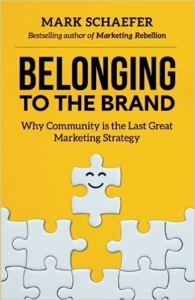Book Review: Belonging to the Brand
Community is our best hope for marketing, according to Mark Schaefer in his new book, Belonging to the Brand. Schaefer posits that traditional marketing techniques such as gating content with forms on landing pages no longer work (largely true), and that today we need to make real connections with our customers if we want to sustain any long-term advantage. It’s a very different approach, and world, from the days when brands could spend their way to awareness and brand preference.
 Building a community takes persistence and a long-term view what success will look like. Then there is the question of where you build your community. This is where the case studies Schaefer has included are in many ways the most valuable part of the book. They show that there are many outlets for communities, from Facebook groups to Discord. It’s what the community offers that makes the difference.
Building a community takes persistence and a long-term view what success will look like. Then there is the question of where you build your community. This is where the case studies Schaefer has included are in many ways the most valuable part of the book. They show that there are many outlets for communities, from Facebook groups to Discord. It’s what the community offers that makes the difference.
-
They started with a purpose that got people interested and involved
-
They make sure the community isn’t a one-way conversation from the brand to customers. They offer a way for people to connect with each other, contribute, and stimulate conversations
-
Some reward heavy participators with spiffs and recognition
-
The owner relinquished some control and let the leaders among the members assume some responsibilities for community operations
-
Selling is not the reason for the community’s existence, although selling of services does occur in many instances
This last point makes it difficult for brands to succeed in community-building, because the community has to have a larger purpose than selling product. A good example is the Boss Mom community started by Dana Malstaff, which started as a way for women to support each other as they took on raising children and starting a business. Based on her experiences and learning from the group, Ms. Malstaff was able to sell coaching services and her books to the community she built.
 The other point that needs emphasizing is that communities need time to grow. Allowances need to be made for mistakes, because in just about every case study the owner made some missteps. It’s also hard to assign an ROI to the activities of a community group, unless there are lots of transactions occurring. This factor can make building a community a tough sell for marketers. So how do you convince your leadership team of the value?
The other point that needs emphasizing is that communities need time to grow. Allowances need to be made for mistakes, because in just about every case study the owner made some missteps. It’s also hard to assign an ROI to the activities of a community group, unless there are lots of transactions occurring. This factor can make building a community a tough sell for marketers. So how do you convince your leadership team of the value?
Schaefer acknowledges that brand community, like brand marketing, is difficult to measure because it’s not transactional. However, it makes sense intuitively that if you establish communication with your customers and build advocacy that will contribute to the success of your company. The best way I’ve found to show the benefits of brand marketing as a whole is to field periodic brand equity studies to see how you rank versus your competition on important attributes and measure your Net Promoter Score (NPS) over time.
After I finished this book I was left with the impression that community-building is important for brands, yet an elusive thing to get your arms around. Perhaps the best way to start is to borrow a page from Simon Sinek and ask “Why?”
Note: No Generative AI was harmed (or used) in the writing of this article.


